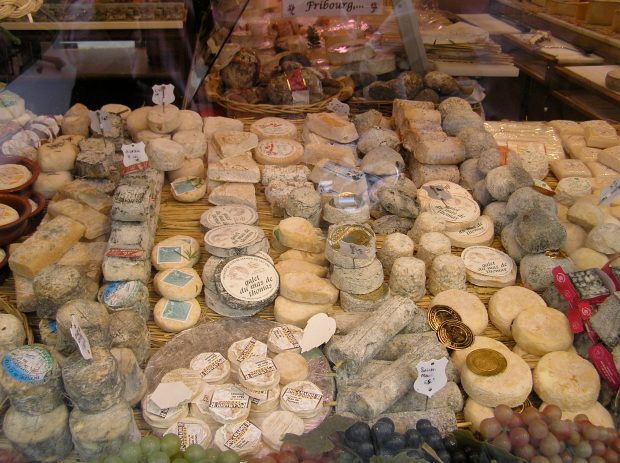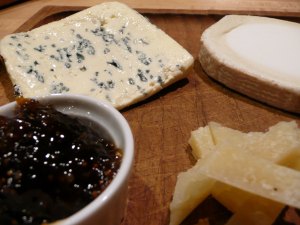
This month’s Barefoot Bloggers bonus recipe was more of a fun free-for-all. Suggested by Rebecca of Ezra Pound Cake, participating bloggers each put together a cheese plate for mass digital/visual consumption. I kept mine very simple, and only included 3 time-tested and well-proven crowd pleasers on the plate — St. Agur (a blue cow’s milk cheese from France), Boucheron (a wonderful goat cheese from France), and Pecorino (a sheep’s milk cheese from Italy that comes in many delectable variations – my favorite is Pecorino Nero):

I thought I would include in this post not only some of my favorite cheeses, but also some standard rules for cheese plate construction that I have picked up from books, restauranteurs, and the occasional honest-to-goodness French person! And they know what they are talking about. All of them. Actually, I spent a year working in a cheese store before I began full-time at an art gallery. And this is what I learned:
1. It is fun to have a theme to your cheese plate, especially if it is served as an hors d’oeuvres course. The theme can be as general as “Cheese from France” or as acute as “Manchego” (featuring the cheese at different stages of aging). Obviously the theme you choose should take into account the type of people you have invited – the uninitiated guest may not appreciate the subtle differences in flavor between Loire valley goat cheese and Corsican goat cheese, but the aficionado may enjoy the challenge – and the type of gathering you are hosting – if you are serving a huge multi-course meal, don’t go too crazy or elaborate with the pre-dinner cheese, but having friends for cocktails can be the perfect time to feature the cheeses you love.
 2. When serving cheese as a course during dinner, it is best to limit yourself to one to three cheeses, as more can overwhelm the palate. In this setting, it is particularly nice to offer a variety – different milks (cow, sheep, and goat), different textures (soft, semi-hard, hard), maybe one blue cheese – and possibly a selection of accompaniments (baguette and walnut bread or crackers; a fig jam or chutney; some honey and walnuts; or a side plate with olives, cured meats, and fresh fruit).
2. When serving cheese as a course during dinner, it is best to limit yourself to one to three cheeses, as more can overwhelm the palate. In this setting, it is particularly nice to offer a variety – different milks (cow, sheep, and goat), different textures (soft, semi-hard, hard), maybe one blue cheese – and possibly a selection of accompaniments (baguette and walnut bread or crackers; a fig jam or chutney; some honey and walnuts; or a side plate with olives, cured meats, and fresh fruit).
3. Always serve cheeses at room temperature for optimal flavor. I usually take my cheese out of the refrigerator 45 minutes to an hour before serving, and leave it in its wrapper until guests arrive.
4. When tasting multiple types of cheese, start with the most mild-flavored (usually the younger cheeses), and move up the scale to the stinkiest or sharpest (blues, washed rind cheeses, etc.) so that you don’t lose your discerning palate before you even begin! For this reason, it is always a good idea to know a little bit about the cheeses you’re serving before the party – ask your cheesemonger for a taste, or at least his/her opinion.
5. As a very general rule, when pairing wines with cheese, it is always a good bet to pick a wine from the same region as the cheese – Epoisses with a red Burgundy, Chaource with a Champagne, a chevre with a Sancerre. Some fun exceptions are the blue cheeses which almost always LOVE a sweeter wine, such as ruby Port or a Sauternes.
So, those are some basic guidelines. The most important one, however, is:
6. KEEP EXPERIMENTING! There are so many wonderful cheeses out in the world, and U.S. farms are now producing some absolutely fantastic examples. Here are a couple of my favorite cheeses:
 St. Agur: pictured on my cheese plate, this is a cow’s milk double-cream blue from the Auvergne region of France. It is less salty and less piquant than other blues, and has a fabulously creamy texture. I sometimes drizzle a little honey over a spread of this for a great contrast of flavors. If it weren’t so gosh darned expensive (about $23/lb.), I’d brush my teeth with it. 🙂
St. Agur: pictured on my cheese plate, this is a cow’s milk double-cream blue from the Auvergne region of France. It is less salty and less piquant than other blues, and has a fabulously creamy texture. I sometimes drizzle a little honey over a spread of this for a great contrast of flavors. If it weren’t so gosh darned expensive (about $23/lb.), I’d brush my teeth with it. 🙂
Robiola & Rochetta: These mixed-milk cheeses are über-creamy (read: runny) and rich, with a flavor that gathers in strength as it ages. I could eat these both (but especially the rochetta) in their entirety with just a baguette and a glass of Bordeaux to wash it down. In fact, please note my last supper request!
Beaufort: This was one of the first cheeses that I truly appreciated. I was introduced to it in Paris by a French woman who insisted that her daily cheese consumption was the reason for her physical fitness. Quite a philosophy! Beaufort tastes similar to gruyere, but has a fruity overtone and a more complex, layered flavor delivered in a subtle progression.
Abbaye de Belloc: This is the most gentle of the cheeses listed here – semi-firm in texture with a creamy, mouth-coating finish and an understated flavor profile. It is pleasing to nearly every palate and, personally, transports me back to the side of a mountain in the Pyrenees. That is one of the wonderful things about food – not only does it taste good, it has the ability to conjure up lovely memories.
Humboldt Fog: When I worked at the cheese shop, this was one of my weaknesses. From the outside, it looks like a brie – it has a bloomy rind and tends to soften (liquefy, really) from the outside in. Through the middle of the cheese is a line of vegetable ash, similar to what you would see in a Morbier. The goat cheese from this west coast producer is almost fluffy in texture, and embodies all that is wonderful in the taste of a good chevre, with a distinctive American look and feel.
Taleggio: I had to wrap up with the stinkiest of my list. This northern Italian cheese has a washed rind, meaning that during the affinage period it is ‘washed’ with a rinse of sea water (some cheeses are washed with wine or brandy too) – this promotes molds that prefer the moist surface, and aids the maturing process. While I have a taste for VERY stinky cheeses too (like Epoisses which is washed with a strong local brandy), taleggio is nice in that the rind has a strong, complex aroma while the interior is more mild and oozy – not nearly as threatening as it seems.
Well, that list of favorite cheeses was longer than I thought! Thanks for reading, and please leave your comments as to your favorite cheeses – I’m always looking for new ones to try! If you can’t get enough cheese, check out the other Barefoot Bloggers’ boards.
We have such similar tastes in cheese! I am a big fan of both robiola and epoisse. I am so excited that my ten-year old daughter also has similar tastes–the stinkier and runnier the better!
And we have a dinner date to make – I promise to supply the cheese! There is a blogger in Seattle who is working on a book called “Hungry Monkey” about raising an adventurous eater – http://www.rootsandgrubs.com/ . I only hope my kids will take after Mommy rather than Daddy!
I’m so jealous – working in a cheese shop would have been so wonderful. I have similar fond memories conjured up by cheeses – in fact I am sitting here smiling to myself at your mention of chaource (memories of eating it with a spoon with my husband).
I’m a fellow cheese lover. Your photo with all the different cheeses is great!
Being surrounded by cheese is a very wonderful thing – I highly recommend it to everyone
Thanks for sharing all that information. And your tray looks lovely. I’ve yet to meet a cheese I don’t like, but I think my very favourite is a smoked Stilton I had several years ago at a little cheese shop in Grassemere in the Lake District of England. Would love to be able to buy that here.
Here’s my platter. It wasn’t too inspired this time.
http://decolady-randommusings.blogspot.com/2009/01/barefoot-bloggers-cheese-platter.html
I’m bookmarking this post! Great tips and cheese suggestions. I’m taking this list with me next time I go to the cheese counter.
Thanks, Rebecca – great idea for the bonus recipe this month!
Great Blog! This post is very informative and interesting as well. Thanks for sharing that kind of post with all of us.